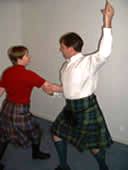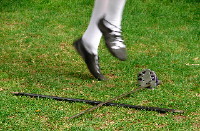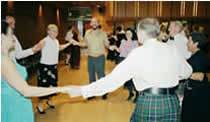RSCDS Brighton Branch
Frequently Asked Questions or FAQs
- Do I need a partner?
- Is it good exercise?
- Is there an age limit?
- Can I dance over swords?
- Do I needs special shoes or clothing?
- What is your Safeguarding (Child Protection) policy?
- What is your Privacy (Data Protection) policy?
- Do I have to study for years and learn all the dances by heart?
- Do I have to wear a kilt?
- Do I have to be Scottish?
- How much does it cost?
- What are the benefits of full membership?
- How can I join as a full member?
Do I need a partner? - No
 No. Usually in Scottish country dancing, dancers take a different partner for each dance. This adds to the social nature of the dancing, and means that you get an opportunity to meet and dance with lots of different people.
Nearly all Scottish country dances need at least six people to dance together. And ladies can ask men to dance as well!
No. Usually in Scottish country dancing, dancers take a different partner for each dance. This adds to the social nature of the dancing, and means that you get an opportunity to meet and dance with lots of different people.
Nearly all Scottish country dances need at least six people to dance together. And ladies can ask men to dance as well!
Is it good exercise? - Yes
Yes! Like most types of dancing, Scottish country dancing is excellent, healthy exercise. And the fitter you are the easier it will be to learn.
Dancing is very good for your heart and lungs and will improve your balance and bone density as well. It has been shown [1] that Scottish country dancers can have more agility, stronger legs, and walk more briskly than other people. We encourage warming up before class and stretching afterwards. But it's not just exercise to keep you fit - you can dance to to great music and have fun at the same time.
Is there an age limit? - No
As long as you are willing to have a good time there is no upper limit on age. We are qualified to teach anyone aged 6 to 106. All you need is to enjoy dancing.

 Can I dance over swords? - Yes
Can I dance over swords? - Yes
Dancing over swords to the sound of the bagpipes is Highland dancing. Use the menu to find out more.
Do I need special shoes or other clothes? - Yes and no
No. For ladies it is more comfortable to wear a wide skirt (so that you can move around). Some men often wear the kilt for dancing, but again it is not essential.
After a few dance evenings most people decide to buy a pair of dancing shoes designed specifically for Scottish Country Dancing, soft leather pumps or ghillies, but beginners should wear any comfortable shoes with a soft non-slip sole, such as jazz or ballet shoes or canvas plimsols. Be prepared to dance in socks if wearing heavy street shoes as some venues might require you to wear soft shoes to protect the floor.
What is your policy for safeguarding children and vulnerable adults?
We take all reasonable steps to ensure that children and vulnerable adults taking part in our activities do so in a safe and secure environment. When children come to our country classes, we ask that a responsible adult accompanies them and dances with them as their partner if they can.In the highland class there is always another adult present as well as the dance teacher, and when children take their exams we ensure they are not left unattended in the exam hall with the examiner, since the examiner is a 'stranger' to the child despite being DBS checked.
Go up to the top of this page
Do I have to study for years before I can go to a dance or Ball? - No
No. There is more emphasis on steps (footwork) than in ceilidh dancing, and the formations can be a little more complex, but the basic technique can be learned at our weekly classes, a local day- or weekend dance workshop or dance weekends organised by RSCDS "HQ" in Scotland.Do I have to learn dances by heart?
No. You don't have to learn any of them by heart if you don't want to, although you should try and learn the steps and formations. Programmes for balls and social dances are published well in advance and weekly classes aim to practise the dances from forthcoming programmes. Also, at the event itself dances are often recapped (always recapped at our Branch dances) or even walked through before the music starts.
Go up to the top of this page
Do I have to wear a kilt?
 No... but if it's good enough for Sean Connery and David Tennant? Men who are used to wearing the kilt find it comfortable for dancing, but many men dance in trousers for several years before investing in a kilt and some always dance in trousers. Women and men should wear clothes in which they feel comfortable and can move easily.
No... but if it's good enough for Sean Connery and David Tennant? Men who are used to wearing the kilt find it comfortable for dancing, but many men dance in trousers for several years before investing in a kilt and some always dance in trousers. Women and men should wear clothes in which they feel comfortable and can move easily.
Dances and balls (see Events) can be formal; men can wear a suit, some with a kilt, and women a smart dress.
Do I have to be Scottish?
No. Scottish Country Dancing is enjoyed the world over, across Europe and North America to Australasia and Japan, by anyone who just loves to dance. There are now more people doing SCD outside Scotland than in it, although in Scotland, people have the advantage of learning it in school.
Go up to the top of this page
How much does it cost?
Class fees are £3 for children and £4 for adult members, a little more for adult non-members. Annual branch membership costs around £25 a year - see the last section below on How to join as a member.
Saturday Scottish balls and dances cost between £3 and £15.

What are the benefits of paying to be a full member of RSCDS?
Apart from receiving the regular RSCDS magazine and being able to attend the Winter School and Summer School, you are contributing to the future of Scottish Country Dancing worldwide. RSCDS work supporting SCD includes:
* publishing books of dances and co-ordinating the SCD repertoire
* training teachers
* running courses for musicians and publishing CDs of dance music
* Youth work, Spring Fling, publicity, medal tests
* supporting branches and affiliated groups,
* providing information about branches and affiliated groups so travellers can find them,
See also the RSCDS HQ member benefits web page. you will pay reduced fees for Brighton Branch classes and if you travel you can be sure you will be made welcome at classes and events run by any branch of RSCDS worldwide.
How can I join as a member?
Download the membership application form, print it, fill it in and pass it with your remittance to Diana, the membership secretary, a committee member or your teacher.Annual membership subscriptions are costed based upon £27 for an adult (see form), normally with a £1 reduction for payments before after 1st July.
Go up to the top of this page
